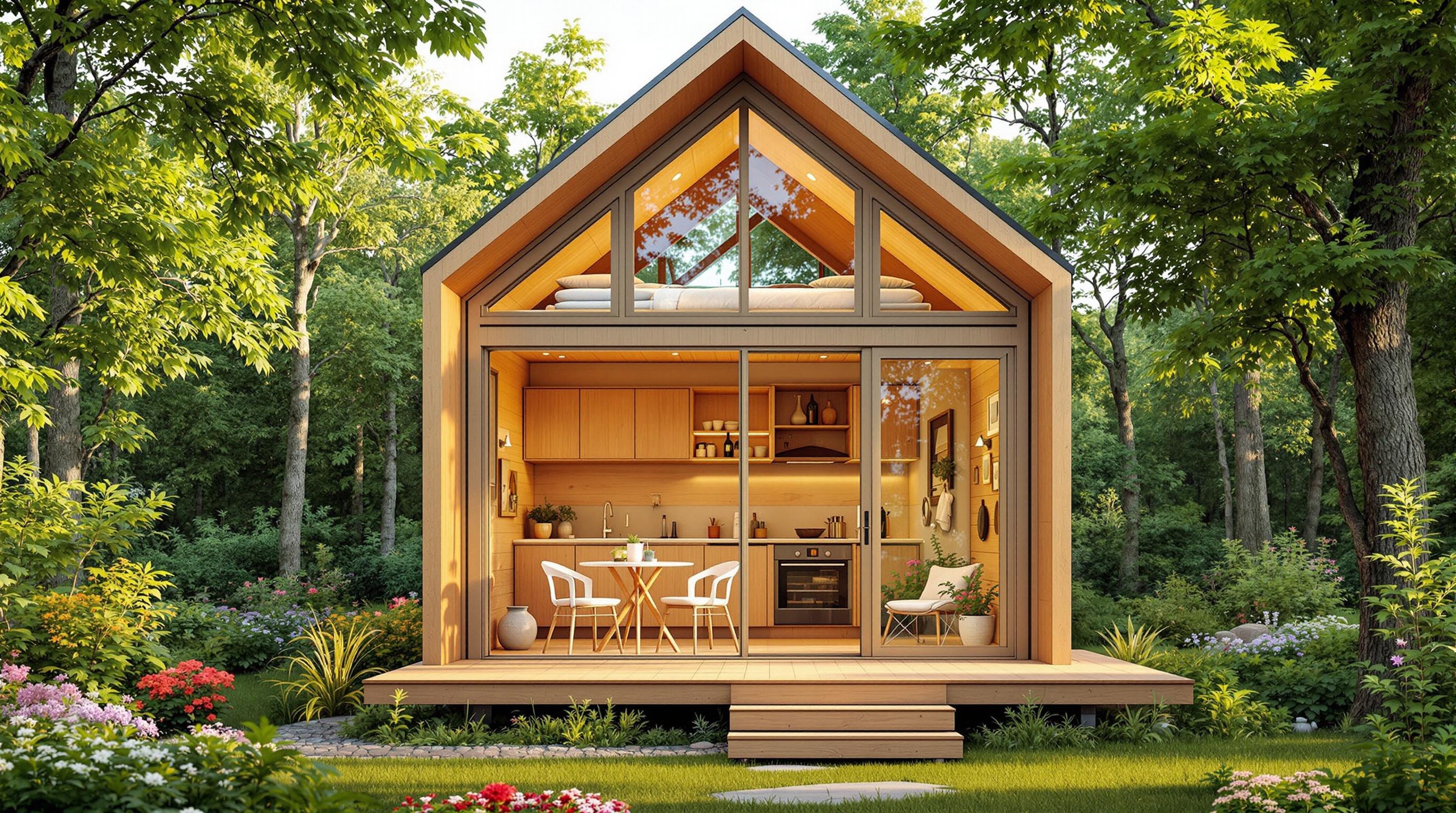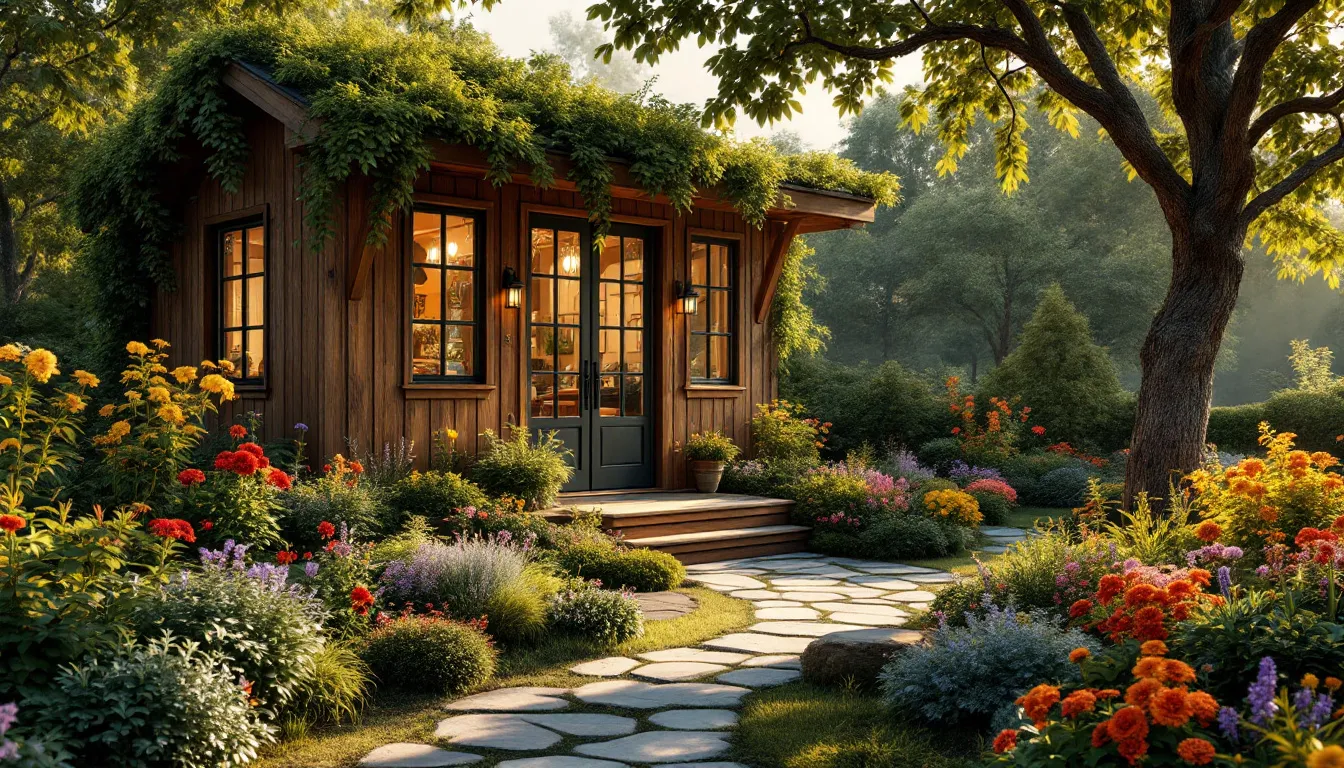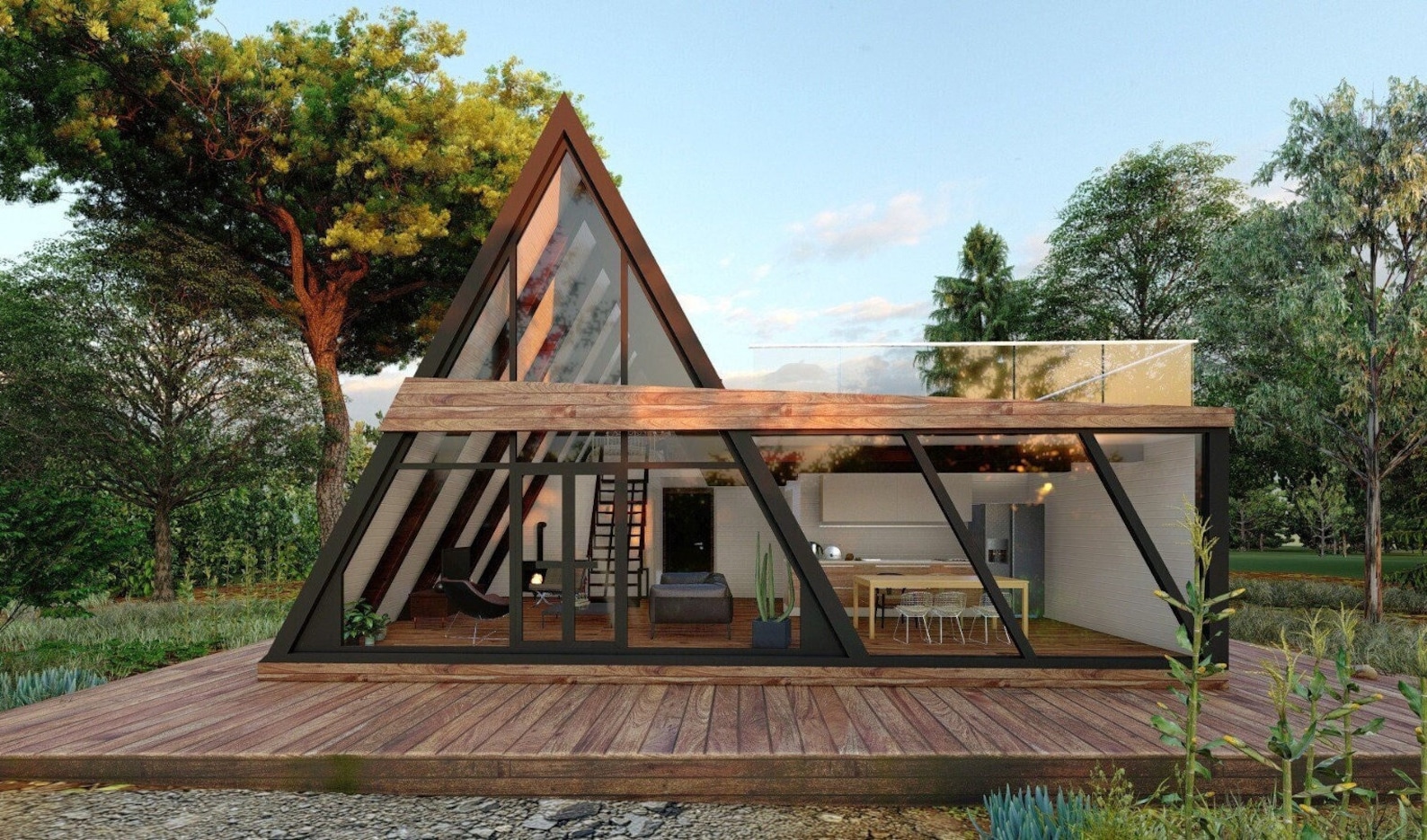A typical tiny house uses just 3-4 kWh per day - about 7% of a traditional home's energy consumption.
Here's what you need to know about powering a tiny house:
- Most tiny homes need 2-5 kW of solar power
- Solar setup costs range from $5,000 to $15,000
- Common power sources: grid connection, solar, generators, or hybrid systems
- Energy-efficient appliances and good insulation are crucial for minimizing power needs
Quick comparison of tiny vs. traditional home power use:
| Aspect | Tiny Home | Traditional Home |
|---|---|---|
| Daily Energy Use | 3-4 kWh | 30 kWh |
| Monthly Electric Bill | $35 (avg) | $115 (US avg) |
| Annual Fridge Operation | $52 | $200-$300 |
| Heating/Cooling Costs | Much lower | Much higher |
Key factors affecting tiny house power needs:
- Appliance efficiency
- Climate and insulation
- Lifestyle and daily habits
- House size
To calculate your tiny home's power requirements:
- List your appliances
- Find their power ratings
- Estimate daily usage time
- Multiply wattage by hours used for each item
- Add up the total
Remember: Efficient design and smart power management are essential for comfortable tiny house living.
Related video from YouTube
Basic Power Needs for Tiny Houses
Tiny houses are power-sipping champions. Let's break down what it takes to keep your compact home running smoothly.
Understanding Watts, Volts, and Amps
First, the basics:
- Watts: power consumption
- Volts: electrical pressure
- Amps: electrical current
Remember this: Watts = Volts x Amps. It's the key to figuring out your tiny home's power needs.
How Much Power Tiny Homes Use
Tiny houses are WAY more efficient than traditional homes. While a standard house might gulp down 30 kWh per day, a tiny house sips just 3-4 kWh. That's an 87% drop!
Here's a real-world example:
| Appliance | Daily Power Usage |
|---|---|
| Minisplit (heating/cooling) | 3,000 watts |
| Fridge | 780 watts |
| Lights | 100 watts |
| Cell phone | 30 watts |
| Laptop | 240 watts |
| Total | 4,150 watts |
That's about 4 kWh daily for a tiny house. Compare that to 29 kWh for an average American home. Big difference, right?
What Affects Power Usage
Your tiny home's power needs can swing based on:
- Appliance efficiency (Energy Star appliances can be game-changers)
- Climate (heating and cooling eat up about 80% of a tiny home's power)
- Your lifestyle and daily habits
- House size (even among tiny homes, size matters)
How to Figure Out Your Power Needs
Calculating your tiny home's power requirements isn't brain surgery. Here's how:
- List your appliances
- Find their power ratings
- Estimate how long you'll use each one daily
- Do the math: wattage x hours used for each item, then add it all up
For example: A 10-watt LED bulb used for 5 hours daily = 50 watt-hours per day.
"Every decision I made during my tiny house build, from choosing LEDs lights, to a super-efficient minisplit system, and an on-demand hot water heater all were chosen to reduce my power consumption." - Ryan Mitchell, Tiny House Expert
Want to make it easier? Try the Renogy solar panel calculator, especially if you're thinking about going solar.
Power Needs for Common Appliances
Let's talk about power in tiny houses. You need to know what your appliances use to keep your compact home running smoothly.
Main Appliances and Power Use
Even tiny houses need the basics. Here's what common appliances typically use:
| Appliance | Power Usage (W) |
|---|---|
| Refrigerator/Freezer | 100-400 |
| Air Conditioner (Window Unit) | 800-1,500 |
| Electric Heater | 500-2,400 |
| Microwave Oven | 600-1,200 |
| Washing Machine | 300-500 |
| Water Heater (150L) | 3,000-4,500 |
Remember, these numbers can change based on the model and how you use it. For example, your fridge might run 12-15 hours a day, turning on and off as needed.
Saving Power with Smart Choices
Want to cut down on power use? Try these:
Induction cooktops are about 90% efficient, way better than gas at 50%. Convection toaster ovens use less power than big ovens. LED lights sip power compared to old-school bulbs. And look for Energy Star labels - they're guaranteed to be efficient.
Power Use Changes with Seasons
Your power needs can swing wildly with the weather. In summer, your AC might be the power hog. Come winter, it's all about heating.
"We've seen power use jump up to 50% in extreme weather. That's why good insulation and efficient heating and cooling are so important." - Tru Form Tiny, luxury tiny home builders
Best Power-Saving Appliances
Want to keep your energy use low? These appliances are your friends:
Tankless water heaters give you hot water without wasting energy. Combo washer/dryers save space and power. Mini-split systems heat and cool efficiently. Compact dishwashers use less water and power than full-size ones. And smart power strips kill that sneaky standby power use.
Ways to Power Your Tiny House
Powering a tiny house isn't simple. Let's look at your options to keep the lights on in your small home.
Connecting to the Power Grid
Plugging into the grid is the easiest way to power your tiny home. It's simple, but it has downsides:
- You get steady power without complex systems
- But you're limited on where you can park
- You'll have monthly bills
- It's not as eco-friendly
"Grid power works for beginners, but it can box you in", says Ryan Mitchell, tiny house expert.
Using Solar Power
Solar power is a big deal for tiny houses. It's clean and great for off-grid living.
Here's what you need:
- Solar Panels: Turn sunlight into electricity
- Inverter: Changes DC to AC for your appliances
- Charge Controller: Manages battery charging
- Batteries: Store power for night use
Most tiny houses need 2-5 kW of solar power. It'll cost you $5,000 to $15,000 for the whole setup.
Want to know exactly what you need? Try the Renogy solar panel calculator.
Backup Power Options
Don't get stuck without power. Here are some backup choices:
1. Gas Generators
Honda EU 2000i costs $949. It gives you 1600 watts and runs for 9.6 hours on 1 gallon of fuel.
2. Solar Generators
Goal Zero Yeti 1250 is $1999. It includes the generator and two 30-watt panels. You get 1250 watts, no noise, and no fumes.
3. Battery Backup Systems
Tesla Powerwall has a 13.5 kWh capacity. It can run a 500-watt fridge for 22.5 hours.
Mixing Power Sources
Why pick just one? Many tiny house owners use a mix:
- Solar + Grid: Use solar first, grid as backup
- Solar + Generator: Perfect for off-grid life
- Wind + Solar: Good for areas with changing weather
EcoFlow sells power kits you can customize. Their "Independence Kit" has a Power Hub, batteries, and a Smart Generator for true off-grid living.
sbb-itb-2ef3f3a
Tips for Managing Power Use
Living in a tiny house doesn't mean you have to skimp on power. Here's how to keep your energy use low and your comfort high.
How to Save Power
Saving power in your tiny home is about making smart choices:
- Switch to LED bulbs. They use up to 75% less energy and last longer.
- Unplug vampire devices. Many appliances draw power even when off. Use power strips to disconnect multiple devices at once.
- Go manual. Try handwashing dishes and air-drying clothes.
- Use DC appliances. They're more energy-efficient than AC ones, as they don't lose power through inverters.
"Consuming less power is great for the environment - and clean energy is even better." - Grit
Spreading Out Power Use
To avoid overloading your electrical system, spread out your power use:
Schedule high-power tasks during off-peak hours. Use timers to run appliances at different times. And be mindful of running multiple high-power appliances at once.
Better Insulation for Less Power Use
Good insulation is key to energy efficiency in tiny homes:
Seal air gaps. Even a tiny 1/16th inch crack can leak as much air as a window open 3 inches. Use quality materials like insulated concrete form (ICF) construction to regulate temperature. And don't forget the roof - ensure it's well-ventilated to reduce cooling needs.
Tools to Track Power Use
Monitoring your energy consumption can lead to big savings. Here are some useful tools:
| Tool | Features | Potential Savings |
|---|---|---|
| Sense Energy Monitor | Identifies individual device power usage | Up to 9% on electric bills |
| P3 Kill A Watt EZ | Plug-load monitor for individual appliances | Varies by usage |
| Smart Home Systems | Real-time monitoring and alerts | 10-15% on energy bills |
These tools can help you spot energy hogs and tweak your habits. By making small changes, you can keep your tiny home powered up without breaking the bank.
Setting Up and Safety
Safety first when it comes to powering your tiny house. Let's look at the must-knows for setting up and maintaining your electrical system safely.
Power System Basics
Every tiny house needs these electrical components:
| Component | Purpose |
|---|---|
| Wiring | Carries electricity through the house |
| Circuit Breakers | Protect against overloads |
| Outlets | Plug-in points for devices |
| Main Panel | Distributes power to circuits |
Most tiny houses do fine with 12-gauge wire for general use (up to 20 Amps). But power-hungry appliances like water heaters? You might need 10-gauge wire.
Safety Rules
Electrical safety isn't something to mess around with. Here's what you need to know:
- Get a certified electrician for the tricky stuff.
- Use GFCI outlets in wet areas.
- Install smoke detectors and check them often.
- Don't overload circuits or use damaged cords.
The National Electrical Code (NEC) is your go-to for wiring standards. Follow it to the letter.
DIY or Pro?
DIY is tempting, but electrical work can be risky. Here's a quick guide:
- DIY: Simple stuff like swapping outlets or light fixtures
- Pro: Main panel work, rewiring, or anything with the main power supply
As Mr. Electric of Dallas puts it:
"When you hire a certified electrician for your tiny home electrical system installation, you can rest easy knowing that your new abode will be efficient and safe for many years to come."
Pro wiring usually costs $1,000 to $3,000 for labor, plus about $500 for materials. It's worth it for safety and peace of mind.
Keeping Your Power System Happy
Regular check-ups keep your tiny house powered safely. Here's what to do:
- Look over electrical cords and outlets monthly.
- Check your circuit breaker panel for overheating or corrosion.
- Test GFCI outlets monthly with the test button.
- Get a pro inspection once a year.
Got solar? Clean those panels and check connections regularly. A well-kept solar system can last 15-25 years, giving you reliable off-grid power.
Conclusion
Powering a tiny house is all about balance. We've covered a lot of ground in this guide, so let's break down the key points:
Tiny houses are energy-efficient beasts. They use just 3-4 kWh per day - that's only 7% of what a regular home guzzles. Why? They're small and smart.
Solar power is the go-to for off-grid tiny homes. With the right setup, you can kiss the grid goodbye.
Sizing matters. Most tiny houses need about 12,400 watts of solar panels to keep the lights on.
Winter is coming. Plan for those short, dark days when your solar panels won't be soaking up as much sun.
Upfront costs can be hefty, but the long-term savings are sweet. Some tiny home owners spend as little as £50 a month on living costs.
Energy-efficient appliances are your friends. LED lights, smart AC units, and energy-star fridges can slash your power use.
Keep tabs on your energy use with calculators and smart control systems.
Here's how tiny homes stack up against traditional houses in terms of power costs:
| Expense | Tiny Home | Traditional Home |
|---|---|---|
| Monthly Electric Bill | $35 (average) | $115 (US average) |
| Annual Fridge Operation | $52 | $200-$300 |
| Heating/Cooling Costs | Much lower | Much higher |
Living tiny naturally means using less energy. As Tim Davidson, a tiny home owner, puts it:
"Tiffany the tiny home is a low energy home that uses a 50amp plug. All the lights are LED, of course, and our tiny home refrigerator is an LG and cost an average of $52 a year according to the EnergyGuide for this unit."
FAQs
How much solar power do I need to run a small cabin?
The solar power needed for a small cabin depends on your daily energy use. Let's break it down:
Say your tiny home uses 24,000 watt-hours per day. A 250-watt solar panel can make about 2,000 watts daily with 8 hours of sun. So, you'd need about 12 solar panels to power your home.
Here's what some common tiny home appliances use:
| Appliance | Watts | Daily Use (hours) | Energy (Watt-hours) |
|---|---|---|---|
| Space heater | 1000 | 8 | 8,000 |
| Refrigerator | 200 | 24 | 4,800 |
| AC unit | 1000 | 7 | 7,000 |
| LED lights (5) | 5 | 5 | 125 |
| Laptop | 40 | 4 | 160 |
To figure out your solar needs:
- List your appliances and their power use
- Guess how long you use each one daily
- Add up your total daily energy use
- Think about how much sun you get where you live
Your location matters. In sunny Florida, a 300-watt panel might make 1.52 kWh/day during the best hours.
"80% of tiny homeowners say saving money is a big reason they go solar." - Tiny House Build
Want to get it right? Try the Renogy solar panel calculator or chat with a solar pro. They can help you design a system that fits your needs and location perfectly.



